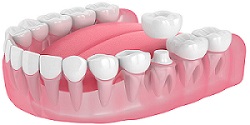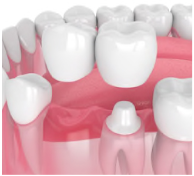GENERAL SERVICES
CROWNS & BRIDGE
Dental Crowns
A Dental Crown is a tooth shaped cap placed over the tooth. Crown is a fixed prosthetic device fabricated to restore the tooth’s shape and size, strength, and improve its appearance. Crown may be used to protect a weak tooth from breaking, to restore a broken tooth or worn out, to restore and support large filling, to hold dental implant, and to make cosmetic modification

Different Crown Materials
- Porcelain-Fused-to-Metal Crown (PFM Crown)
Porcelain-Fused-to-Metal Crown, also called a PFM Crown, consists of a tooth-colored porcelain layer baked onto a metal core. In other words, the entire crown has a porcelain/ceramic layer on top with metal layer underlying. There are different options for the metal base. Commonly used metal materials are metal alloys such as metal alloys, titanium alloys, and gold alloys.
PFM Crowns are more affordable than most ceramic crowns, and stronger with metal underlying. It is, however, not as aesthetic as porcelain crowns. Over a period of time, the gum line of PFM Crowns get darker, which may become visible when you smile. PFM Crowns can be good alternative candidate for back teeth restoration.
- Porcelain Crown
All Porcelain Crowns look like your natural teeth, closely mimicking the tone and translucence of dental ivory. They are highly biocompatible, meaning that it will not cause allergic reactions or cause gum irritation. The Porcelain crowns are singular, precision-crafted in a dental laboratory. It usually takes two or more appointments to restore your tooth with a porcelain crown.
- Metal Crown
There are many options to metal materials as gold, silver, cobalt-chromium, and nickel-chromium; but often prefabricated stainless steel crowns are used as temporary measures. While metal crown has its place in dental history, today’s modern dentistry offers Porcelain/Ceramic crowns for good reasons. People with metal crown often experience significant sensitivity to hold and cold drinks. Also depending on the material, metal crowns can cause allergic reaction or interfere with MRIs.
One-Day CEREC CAD/CAM Crown tech
Our CEREC machine allows us to restore damaged teeth in a shorter period of time. This method begins with a digital impression of your teeth using a special camera that will then generate a 3D model. This allows the Drs. Paul Taehyung Kim to design, fabricate and fit a new customized crown, onlay, or inlay in minimal office visit. Furthermore, the porcelain used to make these restorations closely match the composition of natural tooth structure. Read more about Leading Technology at M Dental Group.
Alternatives to a Crown
An alternative to a dental crown may be a large filling, or for cracked tooth, an inlay or an onlay to cover the tooth. Read more about Fillings, Inlays, onlays. Usually, a dentist will recommend a crown if damage to a tooth structure is severe. If you are considering covering badly stained tooth, or one that is misshapen, you may want to consider veneers as another option .
Dental Bridge
A dental bridge is a pontic (false tooth) that is held in place by abutment teeth on either side of the gap. The dental bridge can be made of gold, porcelain, or porcelain-fused-to-metal. Typically pontic is made with porcelain as the material blends in aesthetically with natural teeth. When you have a missing tooth (or teeth), bridge is recommended to restore your smile, ability to chew, pronounciation, shape of your face, and to prevent your remaining teeth from moving out of the correct position.
When you are missing one or more teeth and if you choose to do nothing, your teeth will shift, our bite will change, and you will eventually lose additional teeth. Depending on a patient’s oral health and number of missing teeth, the doctor will recommend dental bridge, implant, or partial denture. The treatment will fill the space and restore your natural bite and smile.
Different Type of Dental Bridges
When a tooth is missing, a 3-unit bridge can be a good choice for replacing it. In a 3-unit bridge, an artificial tooth is connected on either side to crowns, which are placed on the neighboring teeth to hold the bridge in place. In other words, the crowns serve as restoration for anchoring teeth that have damage or decay. This offers a more secure way to replace a missing tooth.
Cantilever Bridges
Cantilever bridge is used when there is only one anchor tooth available to support the pontic. Typically this bridge is not recommended for use in the back for the mouth where too much bite force can be put on the abutment tooth. However, a situation may occur when abutment is already supporting another prosthetic restoration, or if the cantilevered tooth is the front tooth.

Maryland Bridges (Resin-bonded Bridges)
Maryland bridges (resin-bonded bridges) is a winged bridge that are commonly used to replace front tooth. They are made from a metal framework with procelatin-fused-to-metal teeth. The pontic is fixed to the adjacent stable condition teeth with metal or porcelain wings on either side of the bridge. The Maryland bridge is known for its conservative nature than the traditional bridge because it does not require reshaping and placement of crowns on the adjacent teeth.
Implant supported Bridges
When several neighboring teeth are missing, an implant-supported bridge may be an excellent treatment for replacing them. Because the dental bridges are supported by implants, the treatment does not require reshaping tooth and capping with crown or adding substructures to the adjacent tooth. Your dentist will recommend different type of bridge, implant, or partial denture based on individual oral health conditions as having too many implants together increases risk of complications.
How do I take care of dental bridge?
When you have a dental bridge, it is important to keep the adjacent teeth and gums healthy so they can continue to provide support for the bridge. Brush and floss your teeth and gums normally after each meal to keep your mouth healthy. Take extra flossing underneath and around the abutment teeth to keep plaque from building up. Along with the good oral hygiene, keep your regular checkup appointment with the dentist. During the checkup, dentist or dental hygienist will give you a thorough cleaning, and pay attention to plaque build ups and your oral health. Read more about Regular checkup (Routine Cleaning).